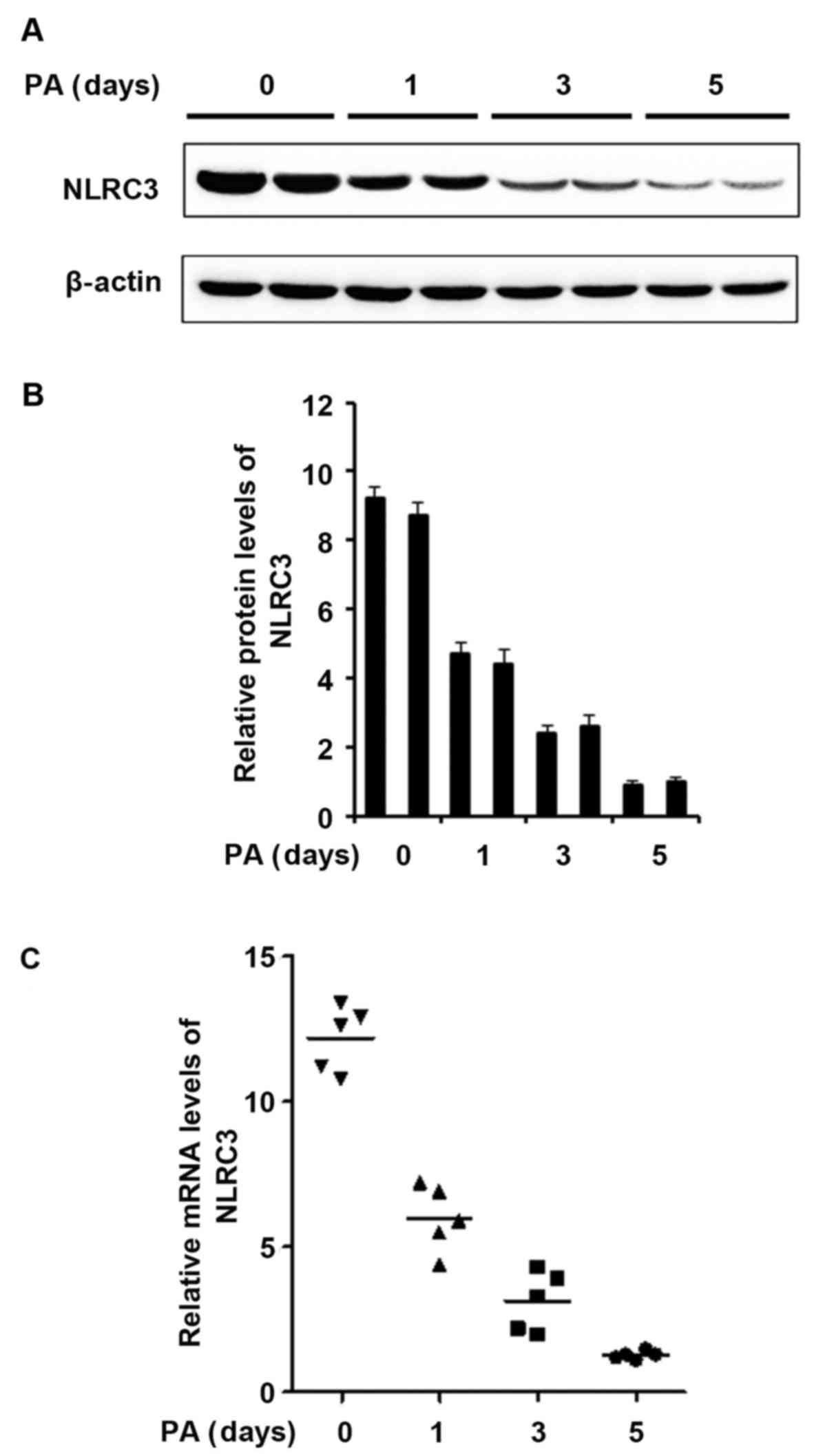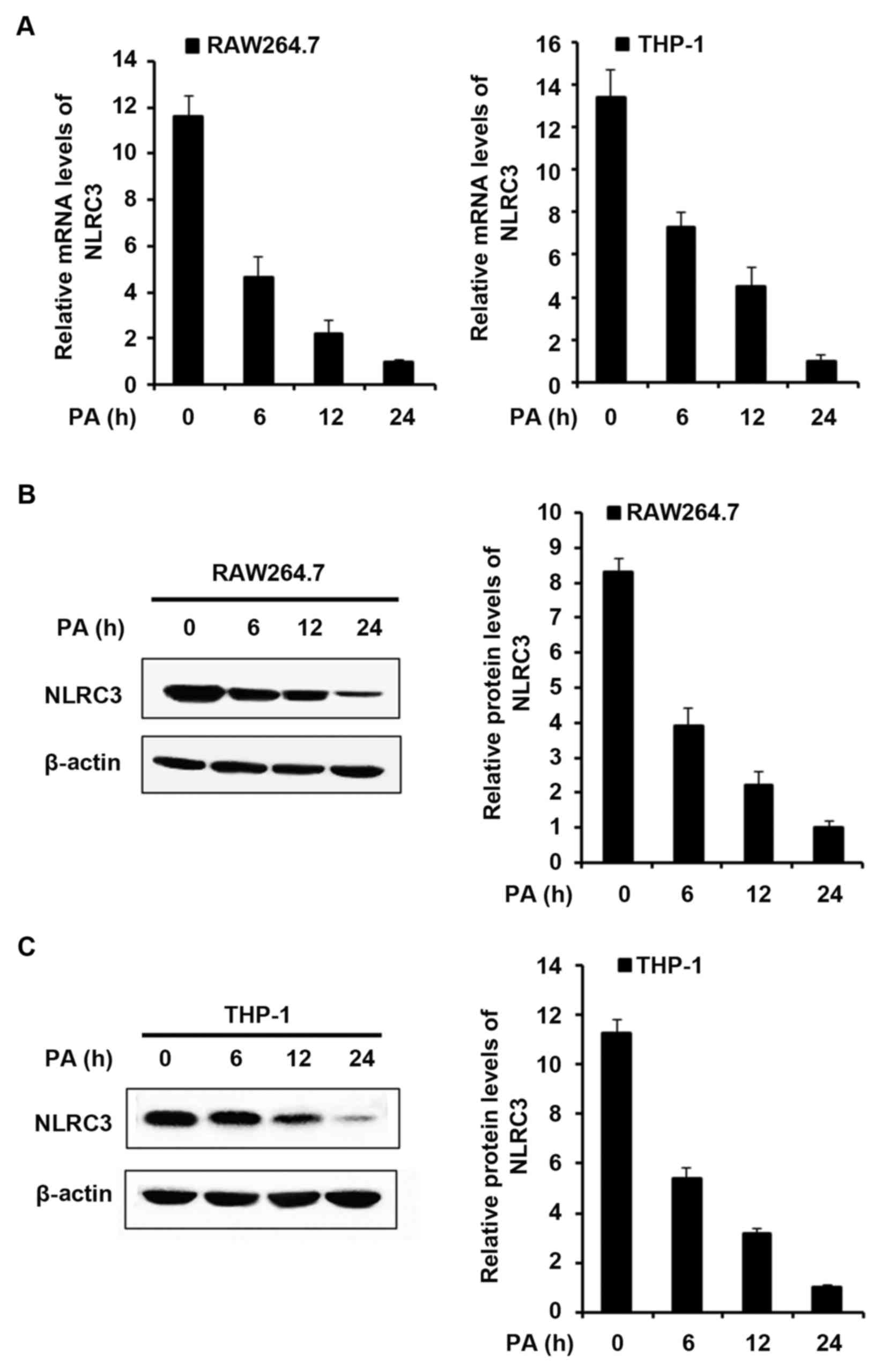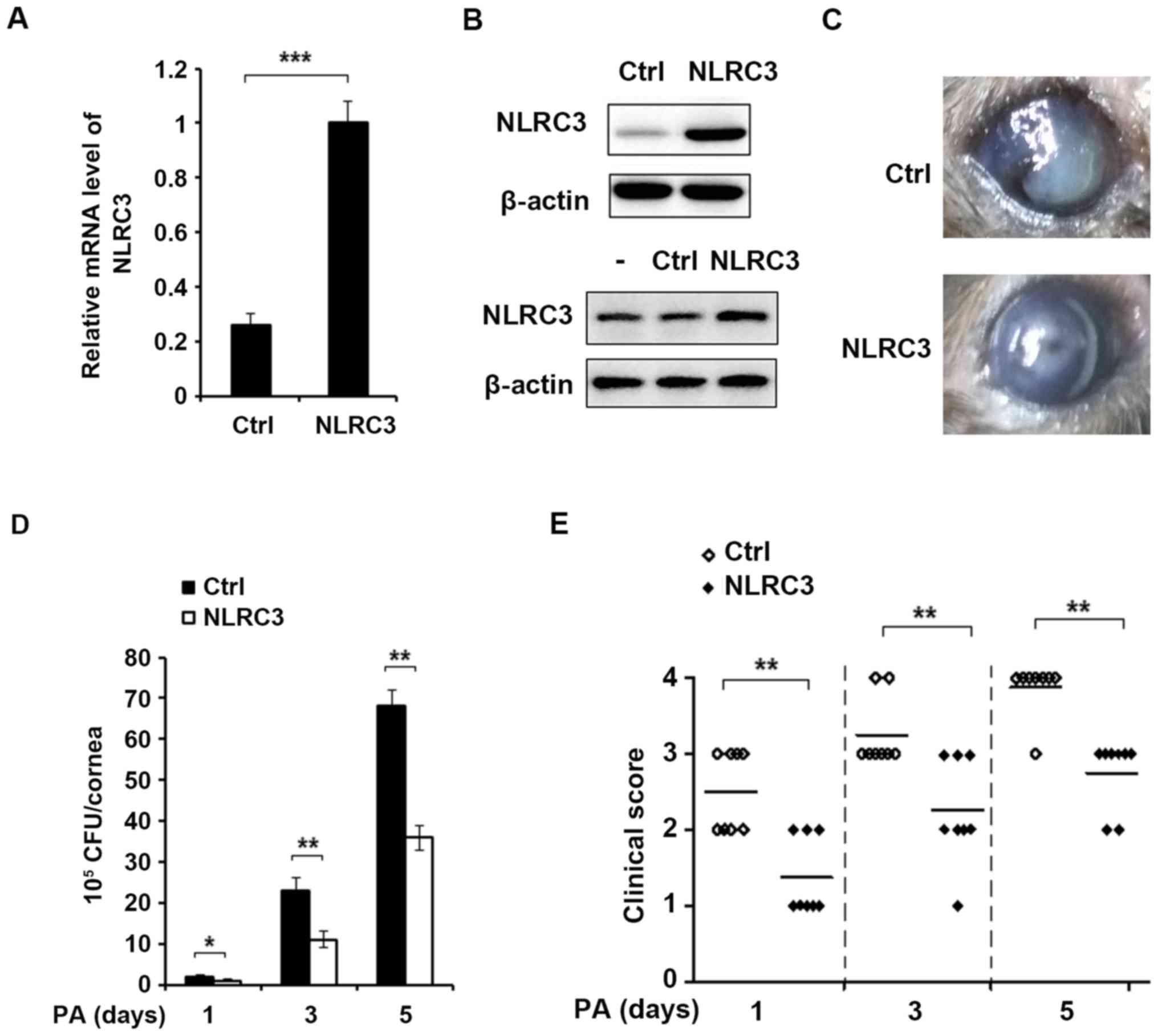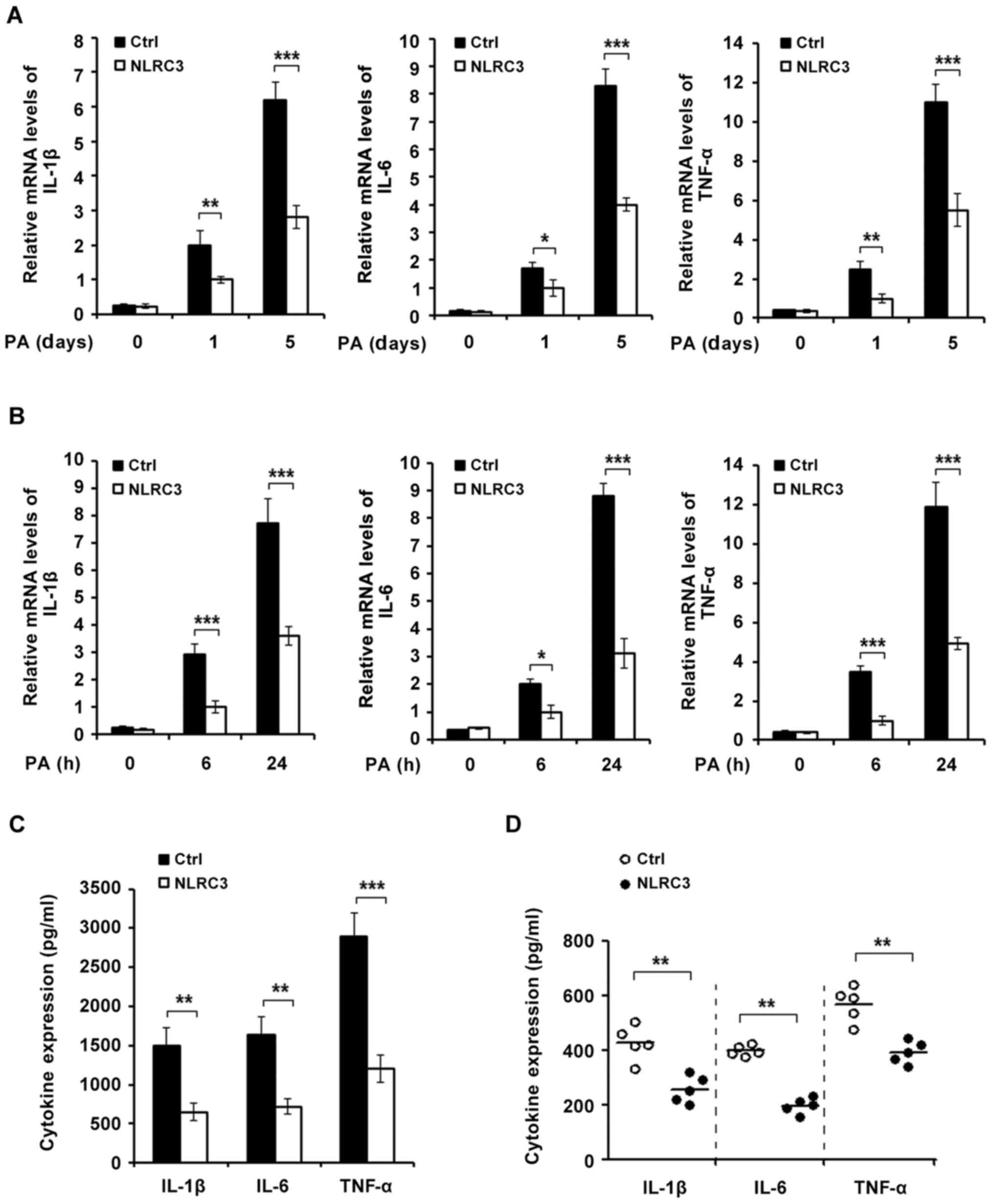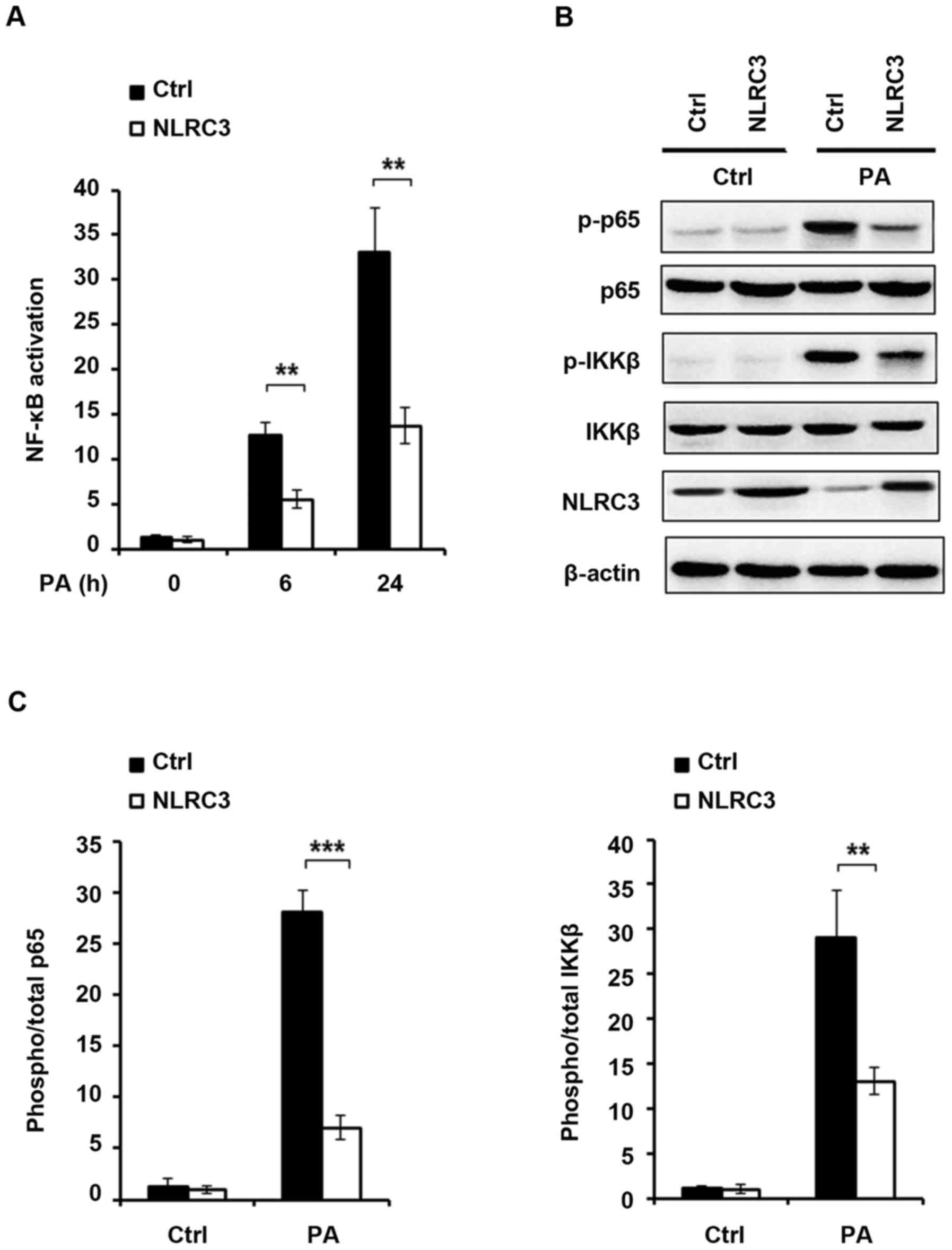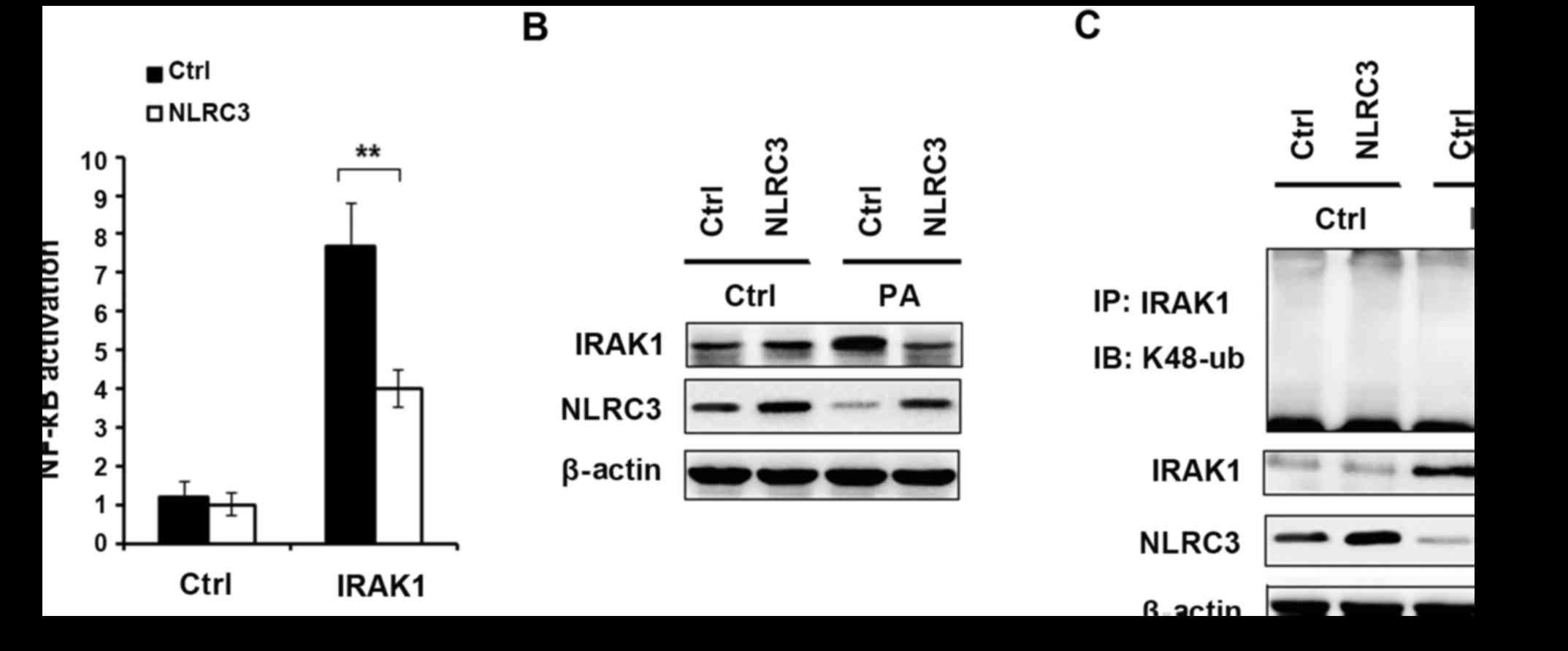Introduction
Pseudomonas aeruginosa (PA), a Gram-negative
opportunistic bacterium, is one of the bacterial species most
commonly isolated from contact lens users with corneal infection
such as keratitis. Keratitis caused by PA is characterized by
stromal infiltrate, epithelial edema and even tissue destruction
(1). Disease progresses rapidly
to cause cornea ulceration and can potentially lead to loss of
vision from corneal scarring without aggressive treatment (2). Even when viable bacteria are cleared
from the cornea, there is often failure to control the
immunopathological damage caused by the excessive local
inflammation through conventional therapies, such as antibiotic
treatment (3). Hence, it is
important to develop new therapeutic strategies for the clinical
treatment of PA-induced keratitis.
The innate host response to invading microbes such
as PA is primarily mediated by innate immune cells, for example
macrophages. Once the bacteria break the anatomical barrier,
macrophages and other immune cells are quickly recruited to the
infection site to engulf invading microorganisms (4). Activated macrophages also produce
various pro-inflammatory cytokines such as tumor necrosis factor-α
(TNF-α), interleukin-6 (IL-6) and IL-1β, which function to enhance
the antibacterial immune response (5,6).
Inflammatory mediators promote the elimination of bacteria;
nonetheless, if uncontrolled, they may augment the inflammatory
response, leading to perforation, tissue damage and loss of vision
in the cornea after PA infection. Therefore, it is important to
precisely balance pro- and anti-inflammatory responses in ocular
immune defense.
The nucleotide oligomerization domain (NOD)-like
receptor (NLR) family proteins are intracellular sensors that have
many functions, including inflammatory and anti-inflammatory roles
(7). Family members share three
characteristic domains: the central NOD, N-terminal protein-protein
interaction domains and a leucine-rich repeat at the C-terminus
(8,9). The most commonly studied subgroup of
NLR proteins is composed of the inflamma-some-forming NLR proteins
(10–12). NACHT, LRR and PYD
domains-containing protein 1 (NLRP1), NLRP2, NLRP3, NLR family
caspase activation and recruitment domain (CARD) containing 4
(NLRC4), NLRC5, NLRP6 and NLRP7 are reported each able to form an
inflammasome complex, which regulates the activation of caspase-1,
leading to the secretion of biologically active inflammatory
cytokines such as IL-1β, IL-18 and IL-33, resulting in effects on
the process and progression of several inflammatory responses and
diseases (11,13–18). Thus, exploring the functions and
mechanisms of NLRs has great significance for the remission and
treatment of human diseases.
NLRC3, belonging to the NLRC subfamily of NLRs, was
firstly identified from human T lymphocytes and is predominantly
expressed in human immune tissues and cells, and it was suggested
that NLRC3 functions as a suppressor of T cell activation (19). In contrast to most NLRs which
activate innate immunity, NLRC3 was reported to inhibit LPS-induced
toll-like receptor (TLR) signaling by inhibiting the adaptor TNF
receptor-associated factor 6 (TRAF6) (20). Recently, NLRC3 was found to be
associated with both STING and TBK1 and impeded STING-TBK1
interaction and downstream type I interferon production in response
to cytosolic DNA, cyclic di-GMP, and DNA viruses (21). But the function of NLRC3 in
PA-induced keratitis and the underlying mechanism still remain
unknown.
In the present study, we showed that NLRC3
expression was attenuated in mouse corneas and macrophages in
response to PA infection. Overexpression of NLRC3 significantly
inhibited the activation of nuclear factor-κB (NF-κB) signaling and
decreased the production of pro-inflammatory cytokines in
PA-infected corneas and macrophages. We also found that NLRC3 could
promote K48-ubiquitination and degradation of IL-1
receptor-associated kinase 1 (IRAK1) after PA infection. In
conclusion, we revealed an anti-inflammatory role of NLRC3 in
PA-induced keratitis in the present study, and suggest NLRC3 as a
potential therapeutic target for PA-induced keratitis.
Materials and methods
Cell culture
Human monocytic leukemia cell line THP-1 and mouse
macrophage cell line RAW264.7 were obtained from the American Type
Culture Collection (ATCC, Manassas, VA, USA). The cells were
cultured at 37°C under 5% CO2 in Dulbecco's modified
Eagle's medium (DMEM) supplemented with 10% FCS (both from
Invitrogen Life Technologies, Carlsbad, CA, USA), 100 mg/ml
streptomycin and 100 U/ml penicillin. Differentiation of THP-1
monocytes to human macrophages was induced by 0.5 mM phorbol
12-myristate 13-acetate (PMA) for 4 h. The differentiated cells
were washed 3 times with phosphate-buffered saline (PBS) and
followed by the further experiments.
Infection
Eight-week-old female C57BL/6J mice were purchased
from Beijing Vital River Laboratory Animal Technology Co., Ltd.
(Beijing, China). The protocol of PA infection was performed as
previously described (22,23).
Mice were anesthetized with ether and placed beneath a stereoscopic
microscope at x40 magnification. The cornea of the left eye was
wounded with three 1-mm incisions using a sterile 25-gauge needle.
A bacterial suspension (5 µl) containing 1×106
colony-forming units (CFUs) of PA ATCC strain 19660 was topically
applied to the ocular surface. Eyes were examined 24 h after
infection or at other times described here to ensure that mice were
similarly infected and to monitor disease.
Clinical examination
Corneal disease was graded as described (24): 0, clear or slight opacity
partially or fully covering the pupil; +1, slight opacity partially
or fully covering the anterior segment; +2, dense opacity partially
or fully covering the pupil; +3, dense opacity covering the entire
anterior segment; +4, corneal perforation or phthisis. The
experiments were carried out according to the National Institutes
of Health Guide for the Care and Use of Laboratory Animals approved
by the Animal Ethics Committee of the Scientific Investigation
Board of Chengde Medical University.
Lentivirus preparation and infection
Lentiviral expression plasmids for NLRC3 were
constructed by MDL Biotechnology, Co. (Beijing, China). Briefly,
the corresponding coding sequence was inserted into the pWPXL
vector (Addgene, Cambridge, MA, USA). Lentiviral particles were
produced through transfection of pWPXL-NLRC3, pMD2.G and psPAX2
plasmids (all from Addgene) with a proportion of 20:15:7 into 293T
cells (ATCC); 3 days later the culture was harvested and enriched
by PEG8000. The enriched lentiviral particles (MOI, 50) were used
for in vitro cell line infection in the presence of 5
μg/ml of polybrene (Sigma-Aldrich, St. Louis, MO, USA).
Subconjunctival injection of the
lentivirus
The protocol was performed as previously described
(25). A lentivirus expressing
NLRC3 (referred as NLRC3-lentivirus below) or the appropriate
control (referred as control-lentivirus below) was
subconjunctivally injected into the left eye of C57BL/6J mice (5
μl/mouse at a viral titer of 1×108) once a week
for three times before ocular infection.
Western blot analysis
For western blot analysis, the in vitro
cultured cells or corneas were harvested after PA infection and
washed three times by ice-cold PBS (MDL Biotechnology, Co.) on ice,
and the cells or corneas were lysed with RIPA buffer (MDL
Biotechnology, Co.) with proteasome inhibitor cocktail (Roche
Diagnostics, Indianapolis, IN, USA), followed by sonication and
homogenization. After centrifugation for 15 min at 13,000 × g, the
supernatants were collected and the protein concentration of the
lysates was measured using Bio-Rad quantification assay (Bio-Rad
Laboratories, Inc., Hercules, CA, USA). Proteins (25 μg)
were separated using 10% SDS-PAGE and transferred to a PVDF
membrane (Millipore, Billerica, MA, USA). The membrane was then
blocked with 2.5% non-fat dry milk for 1 h. The antibodies for
NLRC3 (no. ab77817), IRAK1 (no. ab238) or K48-linked ubiquitin
(linkage-specific K48, no. ab140601) (all from Abcam, Cambridge,
MA, USA) and the antibodies specific for p65 (no. 8242),
phospho-p65 (no. 3033), IKKβ (no. 2678), phospho-IKKβ (no. 2697)
(all from Cell Signaling Technology, Inc., Beverly, MA, USA) and
β-actin (no. sc58673) (Santa Cruz Biotechnology, Inc., Santa Cruz,
CA, USA) were added and incubated overnight at 4°C. After
incubation with the corresponding horseradish peroxidase-conjugated
secondary antibody (Santa Cruz Biotechnology, Inc.), the target
protein was visualized by enhanced chemiluminescence (Thermo Fisher
Scientific, Bremen, Germany).
Ubiquitination assay
To detect ubiquitination of IRAK1, 10 mM
N-ethylmaleimide (Sigma-Aldrich) and 1% SDS were included in the
RIPA buffer (MDL Biotechnology, Co.) with proteasome inhibitor
cocktail (Roche Diagnostics). The whole corneas were collected at
indicated times after PA infection and were lysed in this RIPA
buffer followed by sonication and homogenization. The lysates were
denatured at 90°C for 5 min. The lysates were diluted with RIPA
buffer until the concentration of SDS was decreased to 0.1%. After
centrifugation for 15 min at 13,000 × g, supernatants were
collected and incubated with Protein G Plus-Agarose
Immunoprecipitation reagent (Santa Cruz Biotechnology, Inc.)
together with 1 μg IRAK1 antibody. After 5 h of incubation,
beads were washed 4 times with immunoprecipitation buffer (MDL
Biotechnology, Co.) Immunoprecipitates were eluted by boiling with
1% (wt/vol) SDS sample buffer, and the samples were analyzed by
immunoblotting with the indicated antibodies.
Bacterial plate counts
Corneas from C57BL/6J mice treated with
control-lentivirus or NLRC3-lentivirus were collected at 5 days
post-infection (n=5/group/time), and the number of viable bacteria
was quantitated as previously described (42). Briefly, individual
corneas were homogenized in sterile water containing 0.85% (w/v)
NaCl and 0.25% BSA. Serial 10-fold dilutions of the samples were
plated on Pseudomonas isolation agar (BD Difco;
Becton-Dickinson & Co., Sparks, MD, USA) in triplicate, and
then the plates were incubated overnight at 37°C. Results are
reported as 105 CFU per cornea ± SD.
RNA isolation and quantitative PCR (qPCR)
analysis
The samples were frozen and mechanically dissociated
in TRIzol reagent (Invitrogen Life Technologies). Total RNA was
extracted with TRIzol reagent according to the manufacturer's
instructions. A LightCycler (ABI PRISM 7000; Applied Biosystems,
Foster City, CA, USA) and a SYBR RT-PCR kit (Takara Biotechnology
Co., Ltd., Dalian, China) were used for quantitative PCR analysis.
GAPDH was used as the internal control, and the 2−ΔΔCT
method was used to evaluate the relative quantities of each
amplified product in the samples. For each qPCR analysis, three
technical replicates were performed. Primer sequences used in
quantitative PCR are shown in Table
I.
 | Table IList of primers used in this
study. |
Table I
List of primers used in this
study.
| Genes | Sequence
(5′-3′) |
|---|
| NLRC3 (Mus
musculus) | F:
CTACCCAAGGCATTCAGCCA |
| R:
ACACCTCTTGCTTCCTCGTG |
| NLRC3 (Homo
sapiens) | F:
CCCTGCAGCAATGACTCAAG |
| R:
TGAAGTCGTGTTCCCTCAGC |
| IL-1β (Mus
musculus) | F:
ACCTTCCAGGATGAGGACATGA |
| R:
AACGTCACACACCAGCAGGTTA |
| IL-6 (Mus
musculus) | F:
ACAACCACGGCCTTCCCTAC |
| R:
CATTTCCACGATTTCCCAGA |
| TNF-α (Mus
musculus) | F:
GCCACCACGCTCTTCTGTCT |
| R:
TGAGGGTCTGGGCCATAGAAC |
| GAPDH (Universal
primer) | F:
AATGACCCCTTCATTGAC |
| R:
TCCACGACGTACTCAGCGC |
ELISA assay
For in vivo studies, corneas from
control-lentivirus- and NLRC3-lentivirus-treated mice
(n=5/group/time) were individually collected at 5 days
post-infection and then homogenized in 0.5 ml of PBS with 0.1%
Tween-20. For in vitro studies, the cell supernatants of the
control-lentivirus- and NLRC3-lentivirus-treated RAW264.7 cells
were collected at 24 h post PA challenge. Protein levels of IL-1β,
IL-6 and TNF-α were measured using IL-1β, IL-6, TNF-α ELISA kit
(R&D Systems, Inc., Minneapolis, MN, USA) according to the
manufacturer's instructions.
Dual-luciferase reporter gene assays
Luciferase reporter construct containing the NF-κB
promoter region was cloned into pGL3-based vectors, then
temporarily transfected with 1 μg of the promoter reporter
plasmid into the control-lentivirus- or NLRC3-lentivirus-treated
RAW264.7 cells using jetPEI®-Macrophage
(Polyplus-Transfection, New York, NY, USA), and 40 ng of the
phRL-TK plasmid were co-transfected into the cells to verify
transfection efficiency. After 36 h of transfection, the luciferase
activities were measured on a SpectraMax M5 reader (Molecular
Devices, Sunnyvale, CA, USA) using the Dual Luciferase Reporter
Assay System (Promega, Madison, WI, USA).
Statistical analysis
The differences in clinical score between the
control-lentivirus- and NLRC3-lentivirus-treated corneas were
tested by the Mann-Whitney U test at the indicated days
post-infection. An unpaired, two-tailed Student's t-test was used
to determine the significance of the other assays. Data were
considered significant at P<0.05.
Results
NLRC3 expression is attenuated in mouse
corneas after PA infection
To investigate the role of NLRC3 in PA-induced
keratitis, we first examined the expression of NLRC3 in a
well-established murine model of PA-induced keratitis. As shown in
Fig. 1A and B, the protein level
of NLRC3 was consistently expressed in the normal mouse corneas and
gradually decreased at 1, 3 and 5 days after PA infection.
Consistent with the protein level, the mRNA level of NLRC3 was also
decreased in mouse corneas infected with PA (Fig. 1C). Taken together, these results
indicated that NLRC3 expression was downregulated at both the mRNA
and protein levels in mouse corneas after PA infection, and also
illustrated that NLRC3 may be involved in regulating PA-induced
keratitis.
NLRC3 expression is decreased in in vitro
cultured macrophages after PA infection
During PA infection in the cornea, macrophages and
other inflammatory cells infiltrate in the corneal stroma and
anterior chamber for the clearance of the bacteria (4–6).
To explore the relationship between PA-mediated downregulation of
NLRC3 and infiltrated macrophages, we examined the mRNA expression
of NLRC3 in macrophage-like RAW264.7 cells and human THP-1-derived
macrophages (Fig. 2A). Consistent
with the expression data in mouse corneas, mRNA expression of NLRC3
was significantly decreased in RAW264.7 cells and THP-1-derived
macrophages infected with PA. Furthermore, we confirmed that the
expression level of NLRC3 protein was also significantly
downregulated in these in vitro cultured macrophages after
PA infection (Fig. 2B and C).
Taken together, we hypothesized that the decreased expression of
NLRC3 may be related with the infiltration of macrophages.
NLRC3 delays the disease progression of
PA-induced keratitis
To determine the potential role of NLRC3 in
PA-induced keratitis, C57BL/6 mice were subconjunctivally injected
with recombinant lentivirus containing the overexpression plasmid
of NLRC3 or a lentivirus containing a control empty vector,
followed by PA infection. The overexpression of NLRC3 in mouse
corneas was confirmed by quantitive PCR (qPCR) and western blot
analysis (Fig. 3A and B). The
overexpression of NLRC3 resulted in less corneal opacity in the PA
infected mouse corneas (Fig. 3C).
A reduced bacterial load was detected in the infected corneas of
NLRC3-overexpressing mice compared to the control group (Fig. 3D). Clinical scores showed that
NLRC3-overexpressing mice exhibited less disease severity at 1, 3
and 5 days after PA infection (Fig.
3E). Taken together, these results indicated that
overexpression of NLRC3 delayed the disease progression of
PA-induced keratitis in mice.
NLRC3 inhibits pro-inflammatory cytokine
expression after PA infection
To explore the mechanism by which NLRC3 delays the
disease progression of PA-induced keratitis, we first examined the
expression of pro-inflammatory cytokines by qPCR and ELISA in
lentivirus-treated corneas and macrophages after PA infection.
Overexpression of NLRC3 significantly inhibited the mRNA level of
pro-inflammatory cytokines such as IL-1β, IL-6 and TNF-α, in both
mouse corneas and in in vitro cultured RAW264.7 macrophages
after PA infection (Fig. 4A and
B). Consistent with the mRNA data, the ELISA data indicated
that protein expression levels of IL-1β, IL-6 and TNF-α were also
decreased in the RAW264.7 cells and corneas infected with PA
(Fig. 4C and D). Taken together,
these results illustrate that NLRC3 inhibited pro-inflammatory
cytokine expression after PA infection in vivo and in
vitro.
NLRC3 inhibits NF-κB activation after PA
infection
NF-κB has represented a paradigm for signal
transduction and pro-inflammatory cytokine production implicated in
numerous diseases including PA-induced keratitis (26,27). Therefore, we ascertained wheather
NLRC3 regulates PA-induced keratitis through the NF-κB signaling
pathway. We used Dual-Luciferase reporter assay to examine the
activation of NF-κB signaling, and we found that the promoter
activation of NF-κB was significantly suppressed in the
NLRC3-overexpressing RAW264.7 macrophages compared with the control
group after infection with PA for the indicated time (Fig. 5A). In mouse corneas, NLRC3
overexpression also suppressed the phosphorylation of p65 and IKKβ,
indicating inhibition of the NF-κB pathway (Fig. 5B and C). Interestingly, no change
in NF-κB activation was detected between the NLRC3 overexpression
and control group in the normal uninfected RAW264.7 macrophages or
corneas. Taken together, these findings indicated that NLRC3
inhibits NF-κB activation after PA infection.
NLRC3 promotes degradation and K48-linked
polyubiquitination of IRAK1 in PA-infected macrophages and mouse
corneas
IRAK1 is essential for IL-1, TLR and TNF-α-induced
NF-κB activation (28). After
bacterial infection, IRAK1 is phosphorylated and activated by
IRAK4, leading to activation of TRAF6-dependent signaling (29,30). NLRC3 was also reported to inhibit
LPS-induced TLR signaling via inhibition of the adaptor TRAF6
(20). To further ascertain the
mechanism by which NLRC3 inhibits the activation of NF-κB
signaling, we examined the relationship between NLRC3 and IRAK1.
Dual-Luciferase reporter assay was used to examined the activation
of NF-κB signaling induced by the IRAK1 plasmid. Activation of
NF-κB was significantly inhibited in the NLRC3-overexpressing
RAW264.7 macrophages compared with the control group after PA
infection (Fig. 6A).
Overexpression of NLRC3 also significantly decreased the protein
level of IRAK1 in the PA-infected RAW264.7 cells (Fig. 6B). K48-linked protein
ubiquitination leads to the degradation of the corresponding
protein through 26S proteasome. Therefore, we examined the
K48-linked ubiquitination of IRAK1 in mouse corneas after PA
infection. The K48-linked ubiquitination level of IRAK1 was
increased in the corneas with overexpressed NLRC3 (Fig. 6C). Taken together, these data
indicate that NLRC3 promotes the degradation and K48-linked
polyubiquitination of IRAK1 in PA-infected macrophages and mouse
corneas.
Discussion
In the present study, we investigated the expression
and function of NLRC3 in mouse corneas and in in vitro
cultured macrophages after infection with PA. To the best of our
knowledge, this study is the first publication showing the
relationship between NLRC3 and PA-induced keratitis, and it also
extends our understanding of NLRC3 function.
PA-induced keratitis is a rapidly progressive
corneal disease which often leads to inflammatory epithelial edema,
corneal ulceration, and even tissue destruction or vision loss
(1). It accounts for
approximately three quarters of all cases of contact
lens-associated microbial infection (31). Clinically, doctors often use
different types of antibiotics to eradicate the bacteria (32–34). However, even when the viable
bacteria are cleared from the cornea, sometimes these treatments do
not prevent ocular pathology which is due to the immunopathological
damage triggered by the host inflammatory response (35). Therefore, it is of great
significance to explore the pathogenesis of keratitis and search
for appropriate drug targets.
NLRs are intracellular sensors which comprise a
large receptor family of more than 20 members, and nearly half of
the NLRs have not been characterized in any detail. Most NLRs
positively influence inflammatory responses, particularly the
inflammasome NLRs. Recently, physiological roles for inhibitory NLR
proteins have been described. Intriguingly, all inhibitory NLRs
studied to date have been found to inhibit NF-κB activation. NLRP12
appears to interact with NF-κB-inducing kinase (NIK), TRAF3 and
IRAK1. The interactions appear to regulate the phosphorylation of
IRAK1 and the degradation of NIK, resulting in inhibition of the
NF-κB pathway (36,37). NLRX1 was reported to interact with
TRAF6 and diminish its function, leading to the inhibition of NF-κB
activation in transformed cells (38,39). Examination of NLRC3-knockout
macrophages showed that there was enhanced NF-κB activation
downstream of TLR signaling (20). In previous studies, it was also
reported that silencing of the NLRP3 inflammasome reduced the level
of IL-1β/IL-18 secretion and decreased the level of autophagy,
which impaired the elimination of PA in macrophages (40), and NLRC4 (also known as IPAF)
inflammasome was shown to play critical roles in the activation of
caspase-1 and IL-1β secretion in PA-infected macrophages (16). However, the roles of NLRs in
PA-induced keratitis remain unknown. In the present study, we found
that NLRC3 inhibited NF-κB activation in PA-infected macrophages
and mouse corneas, and overexpression of NLRC3 significantly
inhibited the production of pro-inflammatory cytokines, therefore
ameliorating the disease progression of PA-induced keratitis.
Upon ligand binding to TLR or IL-1R, MyD88 interacts
with the receptor, and IRAK1 binds to MyD88. Then IRAK4
phosphorylates and activates IRAK1. Phosphorylated IRAK1 disengages
from MyD88 and forms a cytosolic IRAK1-TRAF6 complex. TRAF6 then
interacts with TAK1, resulting in eventual activation of the NF-κB
and MAPK pathways (41). Thus,
the regulation of IRAK1 plays an essential role in NF-κB signaling
activation. In this study, we illustrated that NLRC3 could promote
degradation of IRAK1. Furthermore, we found that overexpression of
NLRC3 significantly increased the K48-linked ubiquitination of
IRAK1, which may lead to IRAK1 degradation. These results suggest
that NLRC3 is an inhibitory regulator of IRAK1 and enhance our
understanding of the regulation of IRAK1 and the NF-κB pathway.
Interestingly, we found that NLRC3 expression was
significantly decreased in PA-infected corneas and macrophages.
This phenomenon may be related to the protective role of NLRC3. We
supposed that after PA infection, PA could produce different types
of virulence factors to inhibit the inflammatory responses of the
host, and NLRC3 expression may inhibit these factors therefore
leading to the immune escape of PA. Furthermore, we observed that
K48-linked ubiquitination was improved by NLRC3 overexpression. We
know that NLRC3 only does not have the ability to modulate protein
ubiquitination due to the lack of E3 ligase activity. Thus, we
hypothesized that there are two possibilities: one is that NLRC3
recruits another E3 ligase which directly promotes the K48-linked
ubiquitination of IRAK1; another one is that NLRC3 inhibits the
interaction between IRAK1 and its specific deubiquitinase. However,
the mechanisms by which NLRC3 regulates IRAK1 ubiquitination still
need further study.
In conclusion, in the present study, we found that
the expression of NLRC3 was decreased in mouse corneas and
macrophages after PA infection. Overexpression of NLRC3 by a
lentivirus significantly attenuated PA-induced keratitis
progression, inhibited the activation of the NF-κB signaling
pathway and decreased the production of pro-inflammatory cytokines
after PA infection. Furthermore, we observed that overexpression of
NLRC3 promoted K48-linked polyubiquitination and degradation of
IRAK1 which plays a critical role in NF-κB activation. We revealed
an anti-inflammatory role of NLRC3 in PA-induced keratitis, and
suggest NLRC3 as a potential therapeutic target for PA-induced
keratitis.
Acknowledgments
This study was supported by grants from the Natural
Science Foundation of Hebei Province (no. H2015406054).
References
|
1
|
Hazlett LD: Corneal response to
Pseudomonas aeruginosa infection. Prog Retin Eye Res. 23:1–30.
2004. View Article : Google Scholar : PubMed/NCBI
|
|
2
|
Wilhelmus KR: Review of clinical
experience with microbial keratitis associated with contact lenses.
CLAO J. 13:211–214. 1987.PubMed/NCBI
|
|
3
|
Engel LS, Callegan MC, Hobden JA, Reidy
JJ, Hill JM and O'Callaghan RJ: Effectiveness of specific
antibiotic/steroid combinations for therapy of experimental
Pseudomonas aeruginosa keratitis. Curr Eye Res. 14:229–234. 1995.
View Article : Google Scholar : PubMed/NCBI
|
|
4
|
Hazlett LD: Pathogenic mechanisms of P.
aeruginosa keratitis: a review of the role of T cells, Langerhans
cells, PMN, and cytokines. DNA Cell Biol. 21:383–390. 2002.
View Article : Google Scholar : PubMed/NCBI
|
|
5
|
Kernacki KA, Goebel DJ, Poosch MS and
Hazlett LD: Early cytokine and chemokine gene expression during
Pseudomonas aeruginosa corneal infection in mice. Infect Immun.
66:376–379. 1998.PubMed/NCBI
|
|
6
|
Xue ML, Thakur A and Willcox M: Gene
expression of pro-inflammatory cytokines and chemokines in mouse
eye infected with Pseudomonas aeruginosa. Clin Experiment
Ophthalmol. 30:196–199. 2002. View Article : Google Scholar : PubMed/NCBI
|
|
7
|
Eisenbarth SC and Flavell RA: Innate
instruction of adaptive immunity revisited: the inflammasome. EMBO
Mol Med. 1:92–98. 2009. View Article : Google Scholar
|
|
8
|
Shaw PJ, Lamkanfi M and Kanneganti TD:
NOD-like receptor (NLR) signaling beyond the inflammasome. Eur J
Immunol. 40:624–627. 2010. View Article : Google Scholar : PubMed/NCBI
|
|
9
|
Chang SK, Gu Z and Brenner MB:
Fibroblast-like synoviocytes in inflammatory arthritis pathology:
the emerging role of cadherin-11. Immunol Rev. 233:256–266. 2010.
View Article : Google Scholar : PubMed/NCBI
|
|
10
|
Martinon F, Gaide O, Pétrilli V, Mayor A
and Tschopp J: NALP inflammasomes: a central role in innate
immunity. Semin Immunopathol. 29:213–229. 2007. View Article : Google Scholar : PubMed/NCBI
|
|
11
|
Davis BK, Roberts RA, Huang MT, Willingham
SB, Conti BJ, Brickey WJ, Barker BR, Kwan M, Taxman DJ,
Accavitti-Loper MA, et al: Cutting edge: NLRC5-dependent activation
of the inflammasome. J Immunol. 186:1333–1337. 2011. View Article : Google Scholar
|
|
12
|
Lamkanfi M and Dixit VM: Modulation of
inflammasome pathways by bacterial and viral pathogens. J Immunol.
187:597–602. 2011. View Article : Google Scholar : PubMed/NCBI
|
|
13
|
Masters SL, Gerlic M, Metcalf D, Preston
S, Pellegrini M, O'Donnell JA, McArthur K, Baldwin TM, Chevrier S,
Nowell CJ, et al: NLRP1 inflammasome activation induces pyroptosis
of hematopoietic progenitor cells. Immunity. 37:1009–1023. 2012.
View Article : Google Scholar : PubMed/NCBI
|
|
14
|
Minkiewicz J, de Rivero Vaccari JP and
Keane RW: Human astrocytes express a novel NLRP2 inflammasome.
Glia. 61:1113–1121. 2013. View Article : Google Scholar : PubMed/NCBI
|
|
15
|
Duewell P, Kono H, Rayner KJ, Sirois CM,
Vladimer G, Bauernfeind FG, Abela GS, Franchi L, Nuñez G, Schnurr
M, et al: NLRP3 inflammasomes are required for atherogenesis and
activated by cholesterol crystals. Nature. 464:1357–1361. 2010.
View Article : Google Scholar : PubMed/NCBI
|
|
16
|
Sutterwala FS, Mijares LA, Li L, Ogura Y,
Kazmierczak BI and Flavell RA: Immune recognition of Pseudomonas
aeruginosa mediated by the IPAF/NLRC4 inflammasome. J Exp Med.
204:3235–3245. 2007. View Article : Google Scholar : PubMed/NCBI
|
|
17
|
Elinav E, Strowig T, Kau AL, Henao-Mejia
J, Thaiss CA, Booth CJ, Peaper DR, Bertin J, Eisenbarth SC, Gordon
JI, et al: NLRP6 inflammasome regulates colonic microbial ecology
and risk for colitis. Cell. 145:745–757. 2011. View Article : Google Scholar : PubMed/NCBI
|
|
18
|
Khare S, Dorfleutner A, Bryan NB, Yun C,
Radian AD, de Almeida L, Rojanasakul Y and Stehlik C: An
NLRP7-containing inflammasome mediates recognition of microbial
lipopeptides in human macrophages. Immunity. 36:464–476. 2012.
View Article : Google Scholar : PubMed/NCBI
|
|
19
|
Conti BJ, Davis BK, Zhang J, O'connor W
Jr, Williams KL and Ting JP: CATERPILLER 16.2 (CLR16.2), a novel
NBD/LRR family member that negatively regulates T cell function. J
Biol Chem. 280:18375–18385. 2005. View Article : Google Scholar : PubMed/NCBI
|
|
20
|
Schneider M, Zimmermann AG, Roberts RA,
Zhang L, Swanson KV, Wen H, Davis BK, Allen IC, Holl EK, Ye Z, et
al: The innate immune sensor NLRC3 attenuates toll-like receptor
signaling via modification of the signaling adaptor TRAF6 and
transcription factor NF-κB. Nat Immunol. 13:823–831. 2012.
View Article : Google Scholar : PubMed/NCBI
|
|
21
|
Zhang L, Mo J, Swanson KV, Wen H,
Petrucelli A, Gregory SM, Zhang Z, Schneider M, Jiang Y, Fitzgerald
KA, et al: NLRC3, a member of the NLR family of proteins, is a
negative regulator of innate immune signaling induced by the DNA
sensor STING. Immunity. 40:329–341. 2014. View Article : Google Scholar : PubMed/NCBI
|
|
22
|
Yang K, Wu M, Li M, Li D, Peng A, Nie X,
Sun M, Wang J, Wu Y, Deng Q, et al: miR-155 suppresses bacterial
clearance in Pseudomonas aeruginosa-induced keratitis by targeting
Rheb. J Infect Dis. 210:89–98. 2014. View Article : Google Scholar : PubMed/NCBI
|
|
23
|
Huang X, Barrett RP, McClellan SA and
Hazlett LD: Silencing toll-like receptor-9 in Pseudomonas
aeruginosa keratitis. Invest Ophthalmol Vis Sci. 46:4209–4216.
2005. View Article : Google Scholar : PubMed/NCBI
|
|
24
|
Hazlett LD, McClellan S, Kwon B and
Barrett R: Increased severity of Pseudomonas aeruginosa corneal
infection in strains of mice designated as Th1 versus Th2
responsive. Invest Ophthalmol Vis Sci. 41:805–810. 2000.PubMed/NCBI
|
|
25
|
Chen K, Yin L, Nie X, Deng Q, Wu Y, Zhu M,
Li D, Li M, Wu M and Huang X: β-Catenin promotes host resistance
against Pseudomonas aeruginosa keratitis. J Infect. 67:584–594.
2013. View Article : Google Scholar : PubMed/NCBI
|
|
26
|
Karin M and Lin A: NF-kappaB at the
crossroads of life and death. Nat Immunol. 3:221–227. 2002.
View Article : Google Scholar : PubMed/NCBI
|
|
27
|
Sun Y, Karmakar M, Roy S, Ramadan RT,
Williams SR, Howell S, Shive CL, Han Y, Stopford CM, Rietsch A, et
al: TLR4 and TLR5 on corneal macrophages regulate Pseudomonas
aeruginosa keratitis by signaling through MyD88-dependent and
-independent pathways. J Immunol. 185:4272–4283. 2010. View Article : Google Scholar : PubMed/NCBI
|
|
28
|
Luftig M, Prinarakis E, Yasui T,
Tsichritzis T, Cahir-McFarland E, Inoue J, Nakano H, Mak TW, Yeh
WC, Li X, et al: Epstein-Barr virus latent membrane protein 1
activation of NF-kappaB through IRAK1 and TRAF6. Proc Natl Acad Sci
USA. 100:15595–15600. 2003. View Article : Google Scholar : PubMed/NCBI
|
|
29
|
Suzuki N, Suzuki S, Duncan GS, Millar DG,
Wada T, Mirtsos C, Takada H, Wakeham A, Itie A, Li S, et al: Severe
impairment of interleukin-1 and toll-like receptor signalling in
mice lacking IRAK-4. Nature. 416:750–756. 2002. View Article : Google Scholar : PubMed/NCBI
|
|
30
|
Cao Z, Xiong J, Takeuchi M, Kurama T and
Goeddel DV: TRAF6 is a signal transducer for interleukin-1. Nature.
383:443–446. 1996. View
Article : Google Scholar : PubMed/NCBI
|
|
31
|
Liesegang TJ: Contact lens-related
microbial keratitis: part I: epidemiology. Cornea. 16:125–131.
1997.PubMed/NCBI
|
|
32
|
Kowalski RP, Romanowski EG, Mah FS, Shanks
RM and Gordon YJ: Topical levofloxacin 1.5% overcomes in vitro
resistance in rabbit keratitis models. Acta Ophthalmol.
88:e120–e125. 2010. View Article : Google Scholar : PubMed/NCBI
|
|
33
|
McCormick C, Caballero A, Tang A, Balzli
C, Song J and O'Callaghan R: Effectiveness of a new tobramycin
(0.3%) and dexamethasone (0.05%) formulation in the treatment of
experimental Pseudomonas keratitis. Curr Med Res Opin.
24:1569–1575. 2008. View Article : Google Scholar : PubMed/NCBI
|
|
34
|
Mohammadpour M, Mohajernezhadfard Z,
Khodabande A and Vahedi P: Antibiotic susceptibility patterns of
Pseudomonas corneal ulcers in contact lens wearers. Middle East Afr
J Ophthalmol. 18:228–231. 2011. View Article : Google Scholar : PubMed/NCBI
|
|
35
|
Cowell BA, Willcox MD, Hobden JA,
Schneider RP, Tout S and Hazlett LD: An ocular strain of
Pseudomonas aeruginosa is inflammatory but not virulent in the
scarified mouse model. Exp Eye Res. 67:347–356. 1998. View Article : Google Scholar : PubMed/NCBI
|
|
36
|
Allen IC, Wilson JE, Schneider M, Lich JD,
Roberts RA, Arthur JC, Woodford RM, Davis BK, Uronis JM, Herfarth
HH, et al: NLRP12 suppresses colon inflammation and tumorigenesis
through the negative regulation of noncanonical NF-κB signaling.
Immunity. 36:742–754. 2012. View Article : Google Scholar : PubMed/NCBI
|
|
37
|
Ye Z, Lich JD, Moore CB, Duncan JA,
Williams KL and Ting JP: ATP binding by monarch-1/NLRP12 is
critical for its inhibitory function. Mol Cell Biol. 28:1841–1850.
2008. View Article : Google Scholar :
|
|
38
|
Allen IC, Moore CB, Schneider M, Lei Y,
Davis BK, Scull MA, Gris D, Roney KE, Zimmermann AG, Bowzard JB, et
al: NLRX1 protein attenuates inflammatory responses to infection by
interfering with the RIG-I-MAVS and TRAF6-NF-κB signaling pathways.
Immunity. 34:854–865. 2011. View Article : Google Scholar : PubMed/NCBI
|
|
39
|
Xia X, Cui J, Wang HY, Zhu L, Matsueda S,
Wang Q, Yang X, Hong J, Songyang Z, Chen ZJ, et al: NLRX1
negatively regulates TLR-induced NF-κB signaling by targeting TRAF6
and IKK. Immunity. 34:843–853. 2011. View Article : Google Scholar : PubMed/NCBI
|
|
40
|
Deng Q, Wang Y, Zhang Y, Li M, Li D, Huang
X, Wu Y, Pu J and Wu M: Pseudomonas aeruginosa triggers macrophage
autophagy to escape intracellular killing by activation of the
NLRP3 inflammasome. Infect Immun. 84:56–66. 2015. View Article : Google Scholar : PubMed/NCBI
|
|
41
|
Gottipati S, Rao NL and Fung-Leung WP:
IRAK1: a critical signaling mediator of innate immunity. Cell
Signal. 20:269–276. 2008. View Article : Google Scholar
|















